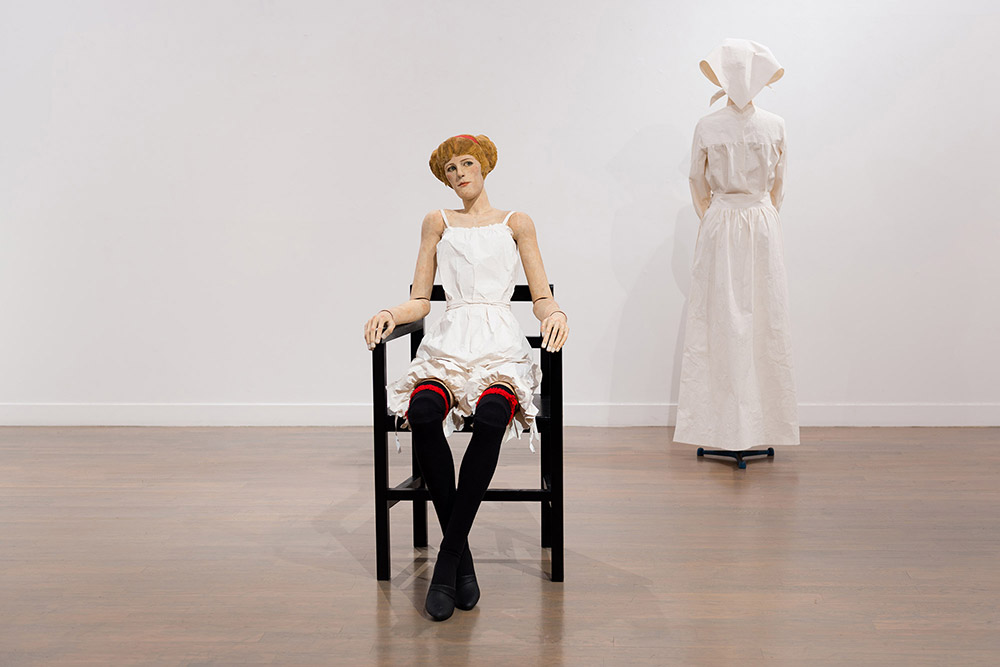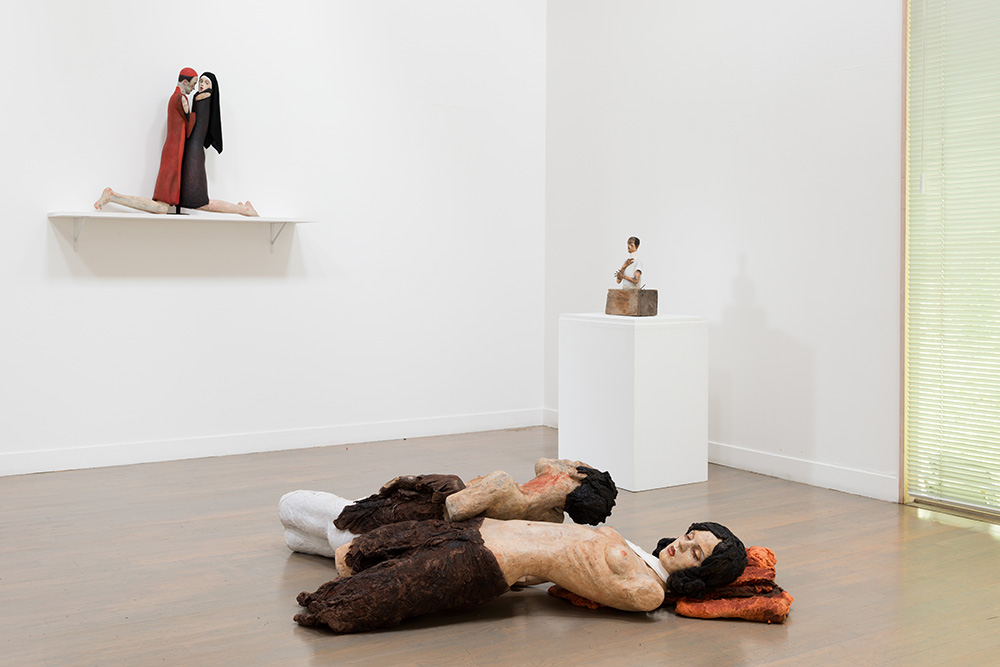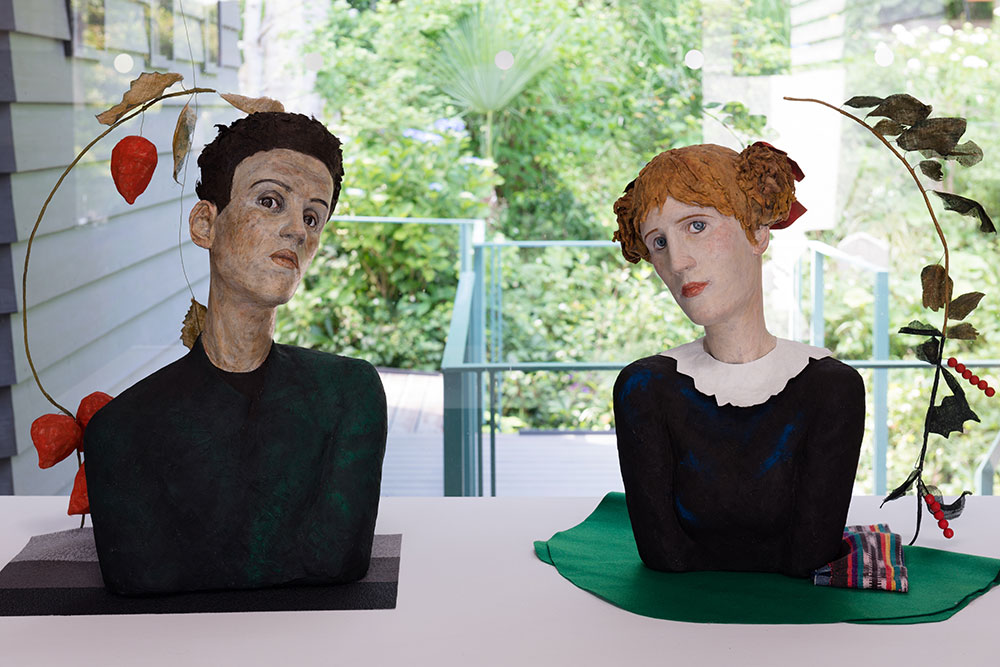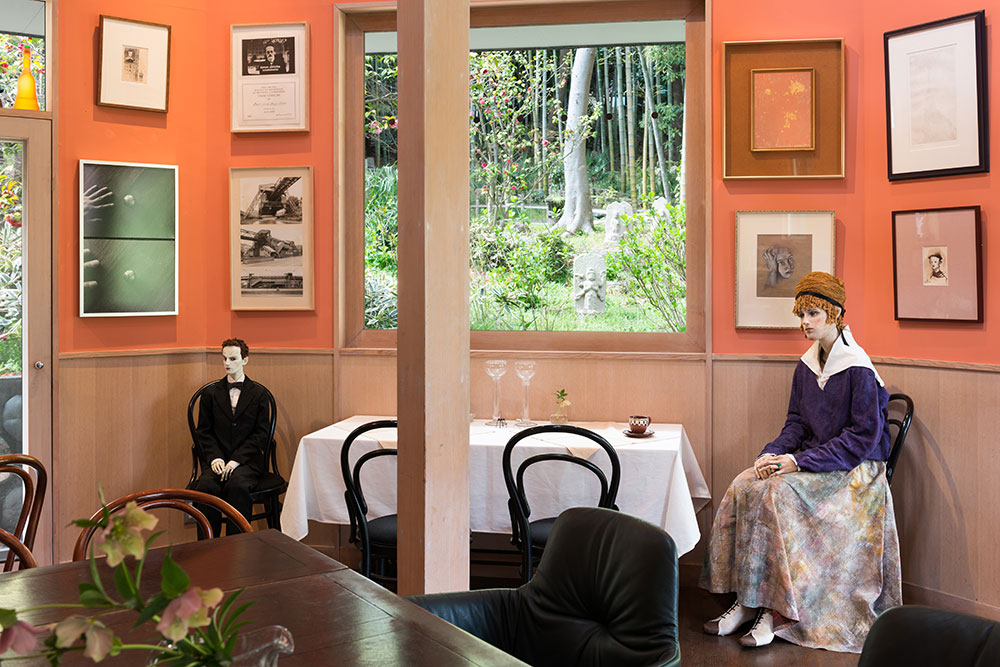
宮崎郁子 “Wally and Egon”
エゴンシーレと共に
2023年3月11日[土]- 5月21日[日]
10:00-17:30(入館は17:00まで)
毎週:月・火・水曜休館
入館料:一般800円、学生600円(小学生400円)
■ 映画監督 – 本田孝義さん撮影・編集による展覧会場の記録映像をYouTubeにて公開いたしました。
■ 会期中 4月16日[日]、5月12日[金]13日[土]最終日の5月21日[日]は作家が在館しております。
■ 会場では宮崎郁子の作品からインスピレーションを得て、オーストリアの映像作家・Bernadette Huberが制作した映像作品も特別上映されます。コマ撮りを駆使し、宮崎の制作したシーレ像に生き生きとした動きを与えています。
■ 当館では現在、国、県からの要請を遵守し、新型コロナウイルスの感染拡大防止策を講じた上で平常通り開館しております。
■ 新型コロナウイルス感染拡大防止のため、会期等が変更となる場合がございます。詳細につきましては、美術館までお問い合わせください。

幼少期より人形に親しみ、独学で作り続けてきた宮崎郁子は1995年に画集を通しウィーンの世紀末転換期の画家エゴン・シーレ(1890-1918)の作品と出会い、その絵画に導かれるようにシーレの残した作品を主題にして自身の制作を続けている。それは、ただ単に絵画の登場人物を造形としてなぞるのでは無く、画面に向かうシーレに時空を越えて寄り添い、モデルたちに触れ、対話するように形作られていく。
前回、2017年に当館で開催された「宮崎郁子 ひとがたのエゴン・シーレ」では等身大のシーレ像や宮崎によって絵画から導き出された瑞々しい姿のモデルたちが観覧者を魅了し、大きな反響を得た。そして同年の晩秋には、嘗てシーレが過ごしたチェスキークルムロフのアトリエで滞在制作する機会が与えられ、そこでは自身よりも大きなシーレ像を日本より持ち込み、共に過ごし、シーレの存在を感じながら新たな作品を制作している。また、翌年の2018年から2019年にかけては、念願であった「Egon Schiele Art Centrum」での個展『エゴン・シーレ没後100年宮崎郁子展』を実現している。一つの目標を達成した宮崎だが、シーレへの思いは尽きることなく、シーレ作品の発するエネルギーを受け止めようと現在も毎日作品を見続けながら無心の制作が続く。それは何か祈りの行為に近い姿にも感じられる。

Wally and Egonによせて
宮崎郁子
この度の展示では、20世紀初頭、ウィーンで活躍した画家エゴン・シーレの芸術上のミューズであり、実質上最初の妻と言われている、ヴァリー・ノイツィルに焦点を当てています。
私は、四半世紀以上シーレ作品の人形としての立体化に取り組み続けていますが、シーレの最重要人物にもかかわらず、私の中のキャラクターとしては未だに確立できていないヴァリーでもあるのです。とても難しい・・私の作ったヴァリーさんは修正、補修を繰り返し、満身創痍の状態です。でも、それがヴァリーでありシーレであるのかもしれません。
爛熟期の世紀末ウィーンの頃、第一次世界大戦が勃発して生きるのも困難だった時代、スペイン風邪が世界に蔓延し、シーレ夫妻も罹患し命を落とし、その前年、シーレときっぱり別れ従軍看護師として戦地に赴いていたヴァリーは猩紅熱にかかり、23歳の若さで亡くなりました。
100年前のヴァリーたちに心をよせてこの展覧会を開催致します。

IKUKO MIYAZAKI “Wally and Egon”
March 11 (Sat) – May 21 (Sun)
10:00 – 17:30 (Last admission 17:00)
Closed on Mondays, Tuesdays and Wednesdays
Admission:
800 yen for adults
600 yen for students
400 yen for elementary school students
■ The artist will be present on March 11, the first day of the exhibition.
■ At the exhibition, a video work by Austrian artest Bernadette Huber inspired by Miyazaki’s work is also presented. Using time-lapse photography, Huber gives the Schiele statue created by Miyazaki a lively movement.
■ We are open as normal with countermeasures against COVID-19 in accordance with the government and local requests.
■ Exhibition schedule is subject to change in response to the evolving COVID-19 situation. Please contact us for further information.
Miyazaki had familiarized herself with dolls since her childhood, and started making dolls on her own. After her encounter with the paintings of Egon Schiele (1890-1918), she creates dolls inspired by Shiele’s works. Her dolls are not merely copies of models in the Shiele’s paintings. Miyazaki’s creation consists of sharing the view with the painter and having a dialogue with the model.
Her past exhibition at Museum Haus Kasuya “Ikuko MIYAZAKI: Egon Schiele Puppetiert” in 2017 was a great success, attracting visitors with a life-size statue of Schiele and fresh-looking models extracted by Miyazaki from paintings.
In the late fall of the same year, she was given the opportunity to stay and work in an atelier in Český Krumlov, where Schiele once resided, and brought a statue of Schiele larger than herself from Japan to create new works while feeling his presence. In the following years, from 2018 to 2019, Miyazaki realized her long-cherished goal of holding a solo exhibition at the Egon Schiele Art Centrum entitled “View of Women – Ikuko Miyazaki and her inspiration by Schiele”. Having achieved one of her goals, Miyazaki’s passion for Schiele has never ceased, and she continues to look at Schiele’s works every day in an effort to catch the energy they emit, which seems like an act of prayer.
On “Wally and Egon”
Ikuko Miyazaki
This exhibition focuses on Wally Neuzil, who was the artistic muse and said to be practically his first wife of Egon Schiele, a Viennese painter active in the early 20th century.
I have been working for more than a quarter of a century to produce statues from Schiele’s works, but I still have a difficulty to establish Wally as a character in my creation, despite being Schiele’s most important figure… My Wally has plenty of wounds due to repeated modifications and repairs, but I guess that is what Vary and Schiele are all about.
In the period of the fin-de-siècle Vienna, where the World War I broke out and it was difficult even to survive, Schiele and his wife lost their lives due to the Spanish flu pandemic. The year before, Wally, who had left Schiele and left for the war front as a military nurse, caught scarlet fever and died at the age of 23.
I am pleased to have this exhibition with my thoughts on Wally and Schiele from 100 years ago.